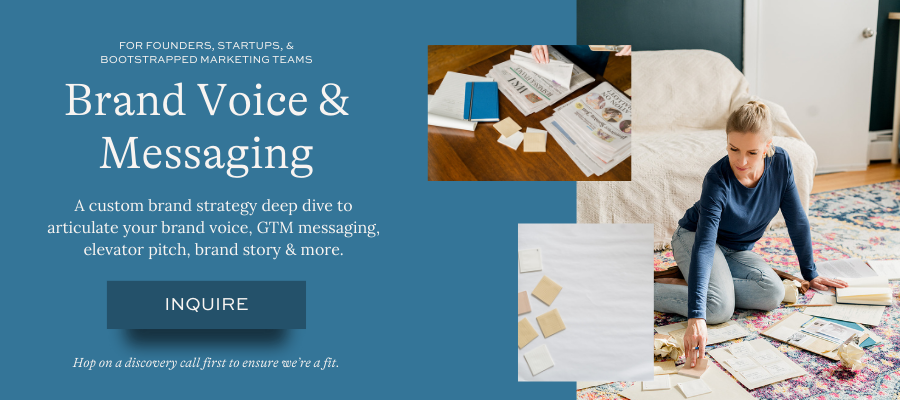If you follow me on LinkedIn, you may have seen my observation that “witty” has become the #1 most requested brand voice attribute for Big Picture clients.
As a conversational copywriter, I understand the appeal. Brands want to connect authentically with their audiences, and a touch of wit can transform standard messaging into something memorable.
But there’s a critical problem lurking behind these one-word brand attributes—a problem that’s costing companies clarity, consistency, and ultimately, connection with their target audiences.
One-Word Brand Attributes Are Meaningless
My reputation as a conversational copywriter makes me the contractor of choice for brands seeking that approachable, engaging tone. But after years of developing voice strategies for companies ranging from startups to multinational corporations, I’ve identified a fundamental flaw in the standard approach.
Consider this: what does “witty” actually mean for different businesses?
- An executive coach
- A healthtech startup
- A multinational co-working corporation
- A global textile manufacturer selling sun shades
What reads as appropriately witty for a co-working space looking to stand out would fall completely flat (or worse, seem unprofessional) for a healthtech company who wants to humanize their brand.
There’s enormous nuance and cultural context behind a single word—especially when it comes to humor and tone.
A word without context has no soul and no power.
Copywriters Should Rethink Their Brand Voice Strategy
This is precisely why I never give clients a simple list of brand personality traits or voice characteristics without describing what each word means specifically for their brand and their unique market position.
But over the past year, I’ve evolved this methodology even further, developing a framework that has transformed how my clients understand and implement their brand voice.
I’ve added a section to my messaging decks that truly personifies the brand by bringing it to life in a way that bullet points simply can’t achieve.
Behold, The Brand Personification Exercise
Here’s the approach: If brand X were a person, they’d be the type of person who…
- Looks forward to…
- Cares about…
- Prioritizes…
- Notices…
- Is intrigued by…
- Loves to…
- Relishes in…
- Is turned off by…
- Creates…
- Believes…
Rather than answering these as single words or bullet points, I craft these into a cohesive paragraph—essentially telling a story in the brand’s unique tone of voice.
Why This Works So Damn Well
What makes this approach powerful is how it transforms the abstract concept of “a brand” into something tangible and human. Something people can grasp intuitively.
The entire purpose of a brand is to reflect your target audience—or perhaps more accurately, to mirror the most aspirational version of themselves.
Remember those childhood conversations where you and your friends would determine what animal each of you would be? It’s similar, except now you’re explicitly articulating the reasoning: “You’re a fox/cat/narwhal because XYZ.”
Founders & Teams Need Practical Application Examples
This personification exercise makes it dramatically easier for clients and their teams to:
- Truly understand their brand essence
- Internalize what makes their voice unique (because they can “hear it” when they see it applied)
- Consistently apply their articulated brand voice across content and communications
- Onboard & train new team members to their brand standards (because they have application examples)
The exercise creates a reference point that’s intuitive rather than prescriptive. Instead of checking a list of attributes like “witty,” “authoritative,” or “approachable,” team members can ask, “Would our brand persona say this? Would they care about this? How would they approach this situation?”
Your Brand Voice Guidelines Shouldn’t Feel Abstract. They Should Feel Mimic-able.
Take Big Picture Copywriting, for example:
Compare “our brand is witty and approachable” to “Big Picture is the type of person who notices linguistic nuance, appreciates self-deprecating humor, and loves connecting complex ideas through, probably too many, unexpected metaphors. But she also loves a quick little aside to bring things back down to earth and keep it real when things start to feel overly academic. She’s kind of like an Aperol spritz in that she could have gone full negroni, but opted for something bubblier, so as not to be mistaken for pretentious. You know what I mean?”
The first provides merely vague direction and the second delivers a precise compass for creating content that sounds like a person and resonates with my specific audience.
You can still have a list of brand voice attributes, but you need to define what they mean for your brand, and then personify it.
How Does This Help The Bottom Line?
Personifying has significantly altered how my clients and their teams implement their brand voice style guidelines. What were once theoretical guidelines have become practical, actionable tools that consistently inform everything from email campaigns to social content to executive communications and website copy.
And when your brand voice achieves this level of specificity and humanity, it transcends being merely an abstract marketing concept. Instead, it becomes something you’ll understand well enough to actually use effectively to form authentic connections with your audience, drive engagement, build loyalty, and ultimately deliver measurable business results.
Commercial Break

I create killer Brand Voice & Messaging decks for my clients that go far beyond the industry standard. While most brand strategists might be satisfied with providing a list of adjectives, Big Picture decks are chock full of Use Case Examples, Campaign Ideas (inspired by your voice/vibe), a Copy Bank Vault and so much more.
Over the last 15+ years, I’ve developed my methodologies to transform how organizations embody their unique voice to deliver messaging that makes their marketing more effective.
